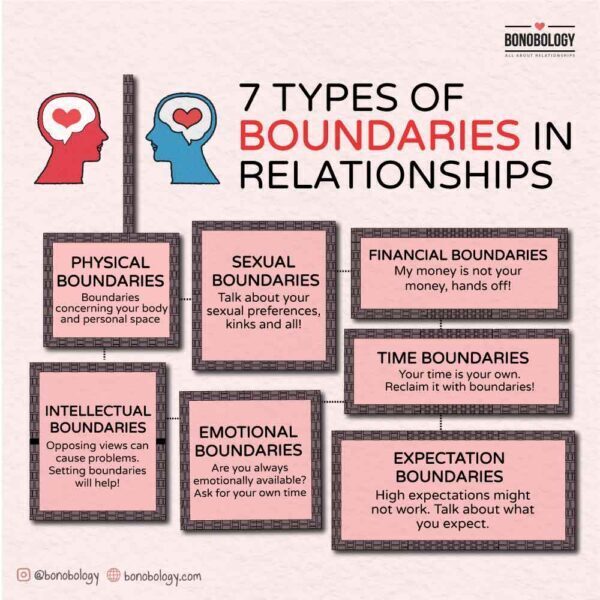“Healthy boundaries protect without isolating, contain without imprisoning, and preserve identity while permitting external connections.” – Anne Katherine, Boundaries: Where You End and I Begin. This quote perfectly sums up the importance of recognizing, setting, and enforcing the different types of boundaries in relationships.
It’s crucial to have a conversation early on in the relationship about the list of personal boundaries both partners would like to enforce because when a couple gets extremely comfortable around each other, the lines between you, I, and we can get blurred easily. Just because you can put your cold feet on your partner’s warm stomach or pop each other’s back acne doesn’t mean you can say just about anything that comes to your mind. Unknowingly, some topics might just hit a nerve.
Even if your relationship seems easygoing, you should still consider discussing boundaries so things don’t go awry. Given that this conversation can get uncomfortable or tricky for most people, we’re here to help you get started. Let’s take a closer look at what are boundaries, and how you can set and enforce them, with insights from psychotherapist Dr. Aman Bhonsle (Ph.D., PGDTA), who specializes in relationship counseling and Rational Emotive Behavior Therapy.
What Are The 7 Types Of Boundaries In Relationships?
Table of Contents
Once the infatuation in a new romance begins to fade, the persistent texts and calls will very quickly go from “cute” to “please make this stop”. In situations like these, following healthy boundaries will do wonders for you in keeping your relationship going. After all, giving space and respecting privacy are two ways to build a healthy relationship. Learning how to claim space for yourself and give your partner theirs can significantly improve your mental health, which can, in turn, help you build a healthier, more wholesome relationship.
Dr. Bhonsle says, “Knowing what boundaries to set in a relationship is an important factor that governs the health of a bond as well as the people in it. It is an act of establishing mutual respect and acknowledging your partner’s rights, wishes, and desires and them, in turn, acknowledging yours.”
Different types of boundaries in relationships will help take you from the cusp of a potentially toxic relationship to a healthy one in which you respect each other’s space. Put in simpler terms, you’ll learn to say “no” and begin to see it as an act of self-care, without worrying about things like, “I don’t want anybody to get the wrong idea about me”. Now that we’ve established their importance, let’s get into what are the different types of boundaries in relationships and how you can set them:
Related Reading: 8 Examples Of Unhealthy Boundaries With Ex-Wife
1. Physical boundaries
Physical boundaries revolve around your body, personal space, and the degree of physical touch you’re comfortable with. Examples of physical boundaries in relationships could include you setting a limit on the PDA you partake in, or just asking for some alone time. Or say, if you’re not big on cuddling, letting your partner know that instead of feeling obligated to reciprocate their advances is also an example of setting a physical boundary.
Voicing your opinion on physical boundaries will prevent misunderstandings and make sure you’re both on the same page. And you don’t have to feel guilty about it. The right amount of personal space is essential for relationships to thrive, as it allows you room to grow, evolve and be in touch with your true self. In Boundaries: Where You End and I Begin, Anne Katherine also writes, “Intimacy comes from being known, and being known requires knowing yourself, having a self to know.”
Examples of physical boundaries in relationships
Of the different types of personal boundaries, respect for physical space can be the most crucial for a lot of people. But how do you convey this to your partner without hurting their feelings or coming across as distant? Here are a few examples that will help you discuss your personal boundaries without causing offense:
- “I don’t like being touched/held this way”
- “I feel tired, I need a break”
- “I’m hungry, I will grab a bite now”
- “I can’t have XYZ in my living space, I’m allergic to it”
- “Please knock before walking into my room”
- “I don’t appreciate being disturbed when I’m in the shower”
- “Don’t bang on the door, loud knocks make me anxious”
2. Sexual boundaries
This is perhaps the most delicate and crucial on this relationship boundaries list. A lot of couples shy away from discussing their sexual expectations, needs, and limitations before getting intimate with each other, fearing that any conversation would ruin the authenticity of the experience. But ask yourself, is fake authenticity more important than making sure you feel safe with your partner?
The latter, right? This is exactly why a conversation about whether you want to have sex, if yes, how and where, what kinks are welcome, and which ones are just straight-up weird is crucial for setting healthy new relationship boundaries. Even if you glossed over it during the early days of your relationship, there is no reason why you can’t do it now.
Dr. Bhonsle says, “Partners should share their fantasies and desires with one another openly and without hesitation or judgment. However, it’s equally important to respect a partner’s reluctance to partake in some of those fantasies and desires. Remember, your partner may not have a sex drive as active as yours or might have had bad experiences with sex in the past. That’s essentially what setting sexual boundaries boils down to.”
Examples of sexual boundaries in a relationship
Sex can turn out to be a touchy topic between partners, especially when it comes to voicing fantasies and kinks and/or turning them down. Here are a few examples of sexual boundaries in a relationship that will help you learn how to say no without bruising your partner’s self-esteem:
- “I’m not enjoying this. Let’s try something different”
- “Would you like to try a new position/experiment with a new technique?”
- “I don’t want to have sex right now. Can we cuddle instead?”
- “I’m not okay with unprotected sex”
- “This hurts/is uncomfortable. Stop”
3. Financial boundaries
A request along the lines of “Hey, can I borrow some money from you? You know I’ll pay you back as soon as I can” shouldn’t leave you incapable of saying no. You should lend money to someone (even if they’re your partner) only if you want to, and not because you fear they’ll lash out and say something like, “Oh so you don’t trust me?” or “Do you value money more than our relationship?”
Drawing a line in the sand about hard-earned money and other material possessions is among the most crucial boundaries in interpersonal relationships, and yes, that includes romantic connections, and shouldn’t be frowned upon at all. It might be an easy conversation, but given how money issues can ruin relationships, it is essential. Besides, learning how talk about finances without getting defensive or touchy can go a long way in improving communication in your relationship. It won’t be a stretch to say that this is one of the most important types of boundaries in relationships that must be addressed.
Examples of financial boundaries
Setting material boundaries in relationships, especially the ones involving money, can be hard. Here are some examples of setting personal boundaries relating to money without it letting it become a sore spot in your relationship:
- “I can’t lend you my car since your name is not on the insurance”
- “I would appreciate if you get the car serviced after the road trip”
- “Let’s go over the credit card bill and divide who owes what”
- “We can’t give out more money to X. Let’s find another way to help out”
- “We should go over the details of the mortgage and decide who pays for what”
- “I would like to keep my personal account active and not have my salary credited in our joint account”

4. Intellectual boundaries
Examples of healthy boundaries in relationships aren’t limited to just physical/monetary aspects. It’s just as important to set intellectual and mental boundaries to be able to navigate divergent views and differences of opinion skillfully. In absence of strong boundaries, even a seemingly nonchalant yet condescending remark on your ideas may be enough to trigger an argument.
At the same time, labeling certain topics as a no-go zone can lead to an undercurrent of tension in your dynamic. You need to go about setting intellectual boundaries tactfully, striking a balance between not limiting the things you two can talk about and respecting each other’s values and opinions.
Related Reading: How Does Cheating Affect A Woman – An Overview By An Expert
Examples of intellectual boundaries in relationships
Intellectual boundaries help you navigate the minefield of differences of opinions skillfully, without letting them take a toll on your relationship. Here are some examples of how to set intellectual boundaries:
- “I know we disagree on this topic, but it doesn’t make it okay for you to belittle me”
- “We never get anywhere in our discussions on this issue. Let’s shelve it for now”
- “Yes, we surely need to talk about this but the dinner table isn’t the best place for it”
- “Let’s agree to disagree”
- “To each their own”
5. Emotional boundaries
Emotions are at the core of romantic relationships, one cannot exist without the other. It’s also equally true that everyone has a different way of dealing with emotions. Setting emotional boundaries in your relationship helps you work through any mismatch in your approach to dealing with and expressing your feelings, without being hurt, confused, or overwhelmed. This becomes even more important when negative emotions are at play.
Healthy boundaries in relationships allow you to see where your partner is coming from or whether they’re in the right headspace to support you when you’re emotionally worked up about something. Being able to understand the emotional dumping vs emotional sharing difference is a rare quality that can set your relationship up for success. And setting personal boundaries vis-a-vis your thoughts, emotions, and feelings is a crucial step in that direction.
“Being emotionally vulnerable with each other is an integral aspect of any romantic partnership, which is why this is among the most crucial boundaries to set in a relationship. The notions of vulnerability can be very different for different people and you need your partner to be a collaborator and not a challenger of your understanding of emotional intimacy and vulnerability. Clearly defined emotional boundaries can facilitate the right kind of collaboration,” says Dr Bhonsle.
Examples of emotional boundaries in relationships
Emotional boundaries are all about validating each other’s feelings and handling any emotional information with respect and care. Here are a few examples of emotional boundaries in relationships:
- “My feelings being criticized make me want to shut down”
- “I can share my feelings with you only when they’re received with respect”
- “I really need to talk some things out right now. Are you in a place to listen?”
- “I’m sorry you’re having a hard time, but I’m not in a place to listen right now”
- “This conversation is making me uneasy. Can we revisit it another time?”
6. Time boundaries
Why does time feature on this relationship boundaries list, you may wonder. Well, because more often than not, feeling overwhelmed in a relationship is one of the signs your boundaries are being violated and your time is not being respected. This can lead to resentment in the relationship, which can seriously damage your bond with your partner.
Healthy relationships rest on a balance between the quality time you spend together and the time you take for self-care and nurturing your individual needs. Dr. Bhonsle says, “When couples come in for therapy on account of partners not being able to spend time with each other, I usually use a ‘zero hour’ assignment. The idea is simple: making an effort to take time out for one’s partner. However, this simple act also conveys love, respect, dignity, and compassion.”
Examples of time boundaries in relationships
Setting time boundaries boils down to being mindful of two things – you have a life outside of your relationship and you need to spend time together as a couple. In line with this paradigm, here are a few examples of healthy boundaries in a relationship with respect to time:
- “I can’t accompany you to that event this weekend”
- “I have plans with my friends”
- “Do you have the time to talk?”
- “Let’s plan weekly date nights”
- “Turning the TV off after dinner will give us time to connect with each other. How do you feel about it?”
Related Reading: 12 Ways To Fix A Toxic Relationship
7. Expectation boundaries
Boundaries on expectations need to be addressed as early as possible. Having high, unrealistic expectations can spell doom for your relationship, especially if they’re not mutual. If you don’t manage expectations in relationships, it could lead to a lot of discontentment and bickering. On the other hand, a conversation about what you can and cannot offer can minimize disappointment and give you clarity on what you can expect from your partner/relationship.
Talking about what’s feasible, how frequently you two will communicate, how available you will be, and who inevitably decides what you’re ordering for dinner are good boundaries to set in a relationship. After all, you don’t want to be caught in an endless loop of “I’ll have whatever you want, but just not that”.
Examples of expectations boundaries
Mismatched expectations can be a breeding ground for emotional unkindness and hostility between partners. That’s why it’s vital to know how to set expectation boundaries realistically. Here are a few examples:
- “While I don’t expect we’ll never fight, I’d like us to resolve those fights maturely”
- “I expect my partner to be loyal and honest”
- “We will both make some mistakes along the way, and that’s okay”
- “What are your expectations from this relationship?”
- “How often should we meet and communicate with each other?”
- “Mutual respect in a relationship is non-negotiable for me”
How To Set Boundaries In Relationships
As we’ve been saying all along, healthy boundaries are important for a happy and long-lasting relationship. The types of boundaries in relationships we’ve discussed today can go a long way in boosting self-esteem, self-worth, and the sense of self of partners. They help you retain your personal space, freedom, and individuality, while allowing you to respect your partner’s.
However, whether you are defining new relationship boundaries or reassessing the terms of engagement in an ongoing relationship, laying out your abilities and limitations on the table is only the first step in the process. Any number of examples of boundaries in a relationship won’t do you any good if you fail to enforce them. Here are some ways of doing it:

- Introduce boundaries early in the relationship – what is acceptable and what is not, habits, routines, etc.
- How to set boundaries in a relationship without being controlling and enforce them diligently? Communication is key. No matter how uncomfortable the conversation is, don’t shy away from it. Instead, handle the issue with respect and compassion
- Be brutally honest about your needs, and comfort. It’s not selfish to prioritize your well-being
- Figure out how you will deal with your partner violating your boundary, or you theirs
- Listen to your partner’s needs as well, don’t fixate on your well-being alone. Know what they are comfortable with and what they will not tolerate
- Don’t hesitate to ask for space when you need it
Key Pointers
- Physical, emotional, and sexual boundaries should be established at early on in a relationship so that both partners feel safe, fulfilled, and cared for
- Time boundaries in a relationship help partners respect each other’s time while also acknowledging the importance of spending quality time together
- Discussions around how you’d engage with each other intellectually, financially, and with respect to expectations are some common boundaries you must address
- Boundaries are key to a happy, successful, and long-lasting relationship. It’s a sign that you share a healthy equation with your partner
Setting boundaries means that you understand the importance of each other’s sense of space and identity, and is a sign of mutual respect in a relationship. Asserting yourself and putting your needs and limitations out there can be daunting at first, but crossing that bridge puts you on the path to building healthy relationships, free of contempt, criticism, and resentment. That makes it a journey worth undertaking.
This article has been updated in April 2023.
FAQs
Realize that the only person’s behavior or attitude that you can control is your own. Focus on your emotions, needs, and wants and know that you’re the only one responsible for them. Focus on your thoughts and actions and be accountable for them.
If you notice the signs your boundaries are being violated, let your partner know that you do not appreciate their approach and tell them their behavior was disrespectful. Communicate the boundary clearly to them again and decide the consequences of what happens if they cross it again. Set a limit to your engagement and be persistent about maintaining your boundaries. Most importantly, remain calm through it all.
Your contribution does not constitute a charitable donation. It will allow Bonobology to continue bringing you new and up-to-date information in our pursuit of helping anyone in the world to learn how to do anything.
Ask Our Expert
You must be Logged in to ask a question.


